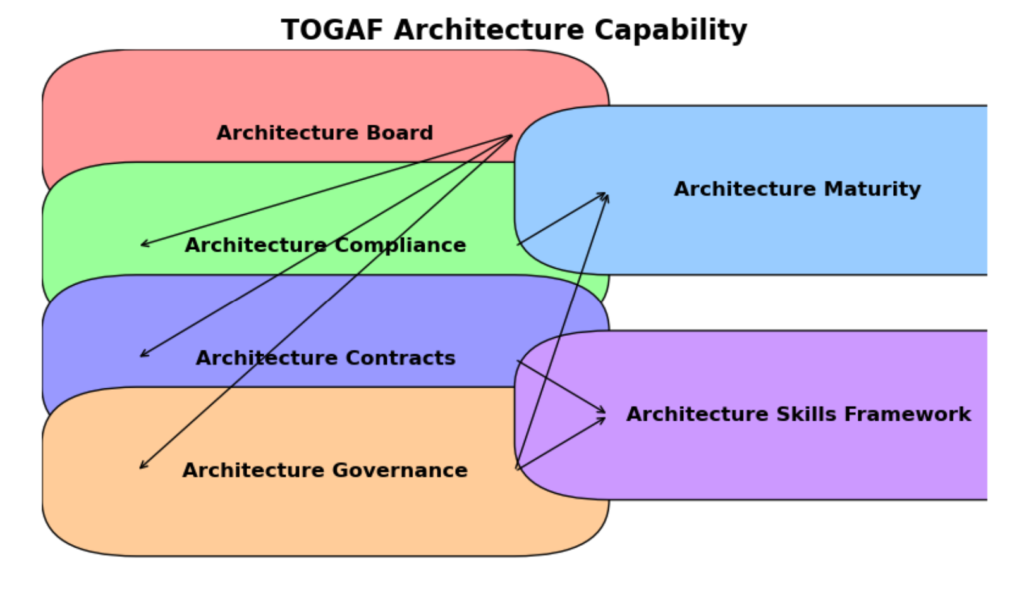-
In TOGAF, Risk Management is a critical component of enterprise architecture governance. It ensures that risks to architecture development and implementation are identified, assessed, and mitigated effectively.
Risk Management in TOGAF is integrated into the Architecture Development Method (ADM) and supports informed decision-making, compliance, and strategic alignment.
🧱 Key Concepts of Risk Management in TOGAF
TOGAF outlines a structured approach to managing risk through the following stages:
- Risk Identification
Recognizing potential threats to architecture initiatives, such as technology failures, compliance issues, or resource constraints. - Risk Assessment
Evaluating the likelihood and impact of identified risks using qualitative or quantitative methods. - Risk Response
Defining strategies to mitigate, transfer, accept, or avoid risks. - Risk Monitoring
Continuously tracking risks and the effectiveness of mitigation strategies. - Governance Integration
Embedding risk management into architecture governance processes to ensure accountability and oversight.
🖼️ Visual Diagram
Here’s a visual representation of the TOGAF Risk Management process:

🌍 Real-World Examples
1. Banking Sector – Core System Upgrade
Scenario:
A bank is upgrading its core banking system, which involves high operational and compliance risks.Risk Management in Action:
- Risk Identification: Legacy system dependencies, data migration errors.
- Risk Assessment: High impact on customer transactions.
- Risk Response: Phased rollout, backup systems.
- Risk Monitoring: Daily risk reviews during migration.
- Governance Integration: Oversight by the Architecture Board.
Outcome:
Successful upgrade with minimal disruption and full regulatory compliance.
2. Healthcare – Electronic Health Record (EHR) Implementation
Scenario:
A hospital network is implementing a new EHR system across multiple facilities.Risk Management in Action:
- Risk Identification: Data privacy, user adoption.
- Risk Assessment: Medium likelihood, high impact.
- Risk Response: Staff training, encryption protocols.
- Risk Monitoring: Weekly audits and feedback loops.
- Governance Integration: Risk reports submitted to the IT governance committee.
Outcome:
Improved patient care and secure data handling with proactive risk mitigation.
3. Retail – Omnichannel Integration
Scenario:
A retail chain is integrating online and in-store systems for a seamless customer experience.Risk Management in Action:
- Risk Identification: System integration failures, inconsistent data.
- Risk Assessment: High likelihood, medium impact.
- Risk Response: API testing, data validation routines.
- Risk Monitoring: Real-time dashboards and alerts.
- Governance Integration: Architecture team reviews risk metrics monthly.
Outcome:
Smooth integration and enhanced customer satisfaction with reduced operational risk.
🧩 Conclusion
Risk Management in TOGAF is not a one-time activity—it’s a continuous, integrated process that supports the success of enterprise architecture initiatives. By embedding risk thinking into every phase of architecture development, organizations can navigate complexity with confidence and resilience.
- Risk Identification
-
In TOGAF, Architecture Capability refers to the organization’s ability to develop, maintain, and govern enterprise architecture effectively. It is not just about tools or frameworks—it’s about people, processes, governance, and maturity.
Architecture Capability ensures that enterprise architecture delivers real business value and aligns with strategic goals.
🧱 Key Components of Architecture Capability
TOGAF defines several core elements that together form the Architecture Capability:
- Architecture Board
A governing body that oversees architecture decisions, compliance, and strategic alignment. - Architecture Compliance
Ensures that projects and solutions conform to the defined architecture standards and principles. - Architecture Contracts
Formal agreements between development partners and architecture teams to ensure alignment. - Architecture Governance
The framework and processes for managing architecture activities and ensuring accountability. - Architecture Maturity
A measure of how well architecture practices are embedded and optimized within the organization. - Architecture Skills Framework
A model for assessing and developing the skills of architecture practitioners.
🖼️ Visual Diagram
Here’s a visual representation of the TOGAF Architecture Capability and its components:

🌍 Real-World Examples
1. Insurance Company – Regulatory Compliance
Scenario:
An insurance firm must comply with new data protection regulations across multiple regions.Architecture Capability in Action:
- Architecture Board defines compliance strategy.
- Architecture Compliance ensures all systems meet regulatory standards.
- Architecture Contracts formalize responsibilities with vendors.
Outcome:
Faster compliance with reduced risk and improved audit readiness.
2. Retail Enterprise – Cloud Migration
Scenario:
A global retailer is migrating its legacy systems to the cloud.Architecture Capability in Action:
- Architecture Governance ensures consistent cloud adoption practices.
- Architecture Maturity assessment identifies gaps in cloud readiness.
- Architecture Skills Framework guides upskilling of IT teams.
Outcome:
Smooth migration with minimal disruption and improved agility.
3. Government Agency – Smart Infrastructure
Scenario:
A city government is implementing smart infrastructure for traffic and utilities.Architecture Capability in Action:
- Architecture Board aligns initiatives with city strategy.
- Architecture Contracts manage collaboration with tech vendors.
- Architecture Compliance ensures interoperability and security.
Outcome:
Efficient rollout of smart services with strong governance and public trust.
🧩 Conclusion
Architecture Capability is the foundation of successful enterprise architecture. By investing in governance, skills, and maturity, organizations can ensure that architecture is not just a theoretical exercise—but a strategic enabler of transformation.
- Architecture Board
Tag